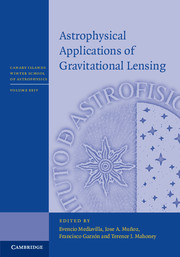Book contents
- Frontmatter
- Contents
- List of contributors
- List of participants
- Preface
- Acknowledgements
- 1 Lensing basics
- 2 Exoplanet microlensing
- 3 Four case studies of microlensing
- 4 Gravitational (micro)lensing of quasars and AGN
- 5 Dark matter in clusters and large-scale structure
- 6 The future of strong lensing
- 7 Methods for strong lens modelling
- 8 Tutorial on inverse ray shooting
- References
1 - Lensing basics
Published online by Cambridge University Press: 05 September 2016
- Frontmatter
- Contents
- List of contributors
- List of participants
- Preface
- Acknowledgements
- 1 Lensing basics
- 2 Exoplanet microlensing
- 3 Four case studies of microlensing
- 4 Gravitational (micro)lensing of quasars and AGN
- 5 Dark matter in clusters and large-scale structure
- 6 The future of strong lensing
- 7 Methods for strong lens modelling
- 8 Tutorial on inverse ray shooting
- References
Summary
The field of gravitational lensing has evolved from a theoretical fantasy to a robust astrophysical tool in the past few decades. In this chapter, we introduce the basics of gravitational lensing. We explain what gravitational lensing is in Section 1.1 and briefly recount the history of lensing in Section 1.2. We continue with the basic theory for lensing in Section 1.3 and work through properties of simple lens mass distributions in Section 1.4.
Introduction
A perhaps familiar example of lensing is the bending of light by optics, such as the glasses that some people wear, or binoculars that some people use for viewing wildlife or events. These two examples of optical lenses are linear in the sense that one sees only a single (perhaps magnified) image of the object of interest. In contrast, the base of a wine glass is a non-linear lens so that through the glass one can see multiple images of the background object. Figure 1.1 is an illustration of this phenomenon. In the top-left panel, we see the original source of light that emanates from the candle. In the top-right panel, we see four images of the source as lensed by the wine glass: one in the lower left, two close pairs on the lower right and one behind the stem of the wine glass. By tilting the base of the wine glass, we change the properties of the optical lens and thus the light paths of the images we see. For example, in the bottom-right panel, there are only two multiple images of the background source. In the case where the stem of a symmetric wine glass is aligned perfectly along of the line of sight to the source, the source is lensed into a ring, as shown in the bottom-left panel.
In gravitational lensing, a massive object takes on the role of the lens, similar to the wine glass in optical lensing. According to Einstein's General Theory of Relativity, mass curves spacetime. Light, taking the shortest path in this curved spacetime, thus ‘bends’ around massive objects. Anything that has mass (e.g. planets, stars, galaxies, and clusters of galaxies) can thus act as a gravitational lens.
- Type
- Chapter
- Information
- Astrophysical Applications of Gravitational Lensing , pp. 1 - 30Publisher: Cambridge University PressPrint publication year: 2016

